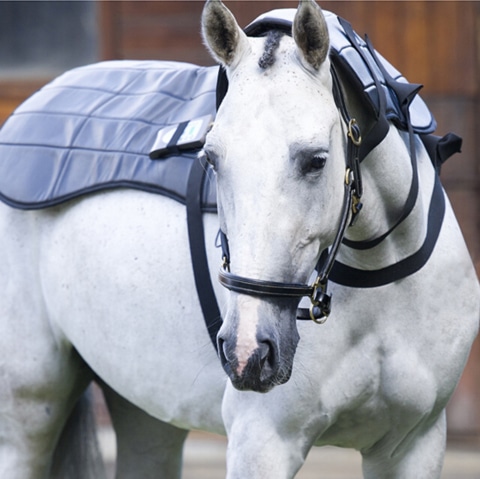Hot pads, cold pads, massage machines, magnetic rugs, red light lasers … but which to use on what injuries? SUZY JARRATT investigates.
In this article, we look at several types of injury and some of the commercial therapies available. But prior to using any form of therapy, you should always have your vet access the situation. You might think you know what’s wrong with your horse, but without expert advice, you could choose the wrong treatment and exacerbate the problem.
With that said, applying either hot or cold treatments are well-established remedies for injuries.
Cold therapy: generally for recent injuries (within two to seven days). It can reduce inflammation and swelling, and provide pain relief. Icing, as it’s sometimes called, can also be used preventatively post-workout. Ways to apply cold therapy include cold-hosing, ice boots, and wrapping an ice pack around the leg.
Heat therapy: more commonly used for chronic issues to improve blood flow, which helps healing by increasing oxygen in the area. It should not be applied on an open or bleeding wound, and not until acute inflammation has subsided (about a week after surgery or injury). Generally used for wound healing, heat therapy is also beneficial for spasms. It relaxes muscles and makes for a great pre-workout regimen. Apply hot water with a hose or bucket, or use a heat pack. Since heat therapy can cause tissue damage if applied incorrectly, ask your vet to demonstrate the right way to do it.
Heat can be applied almost anywhere, so long as you can keep it in place for the required time. It should always be used at rest and care should be taken to not overheat vulnerable tendons in the lower limbs. As a general rule, heat should be applied for around 20 minutes at a time up to four times a day.
Therapeutic Products
There are many on the market, but choosing the right one is paramount. Plus, every horse is different, so therapy effectiveness will vary depending on the animal. Understanding what a device does and whether it’s likely to help is a good start – so before investing, do your research, attend information sessions, or, if possible, borrow the one you’re considering buying.
Massage pads: These have variable settings. Low is recommended for cool down after exercise, if your horse is sensitive, or if the pad is being introduced for the first time; Medium will help warm muscles up prior to work; and High is for the horse that prefers a more intense massage.
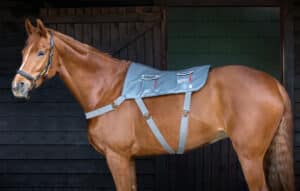
Massage mitts: Hand-held and lightweight, they soothe and relax muscles with comforting heat.
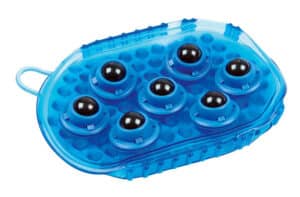
Massage gun: This imitates a deep tissue massage delivered through various heads which knead, vibrate or beat. It can decrease muscle soreness and enhance overall health. The gun makes no sound, and most horses enjoy being massaged.
Magnetic devices: Magnetic rugs can aid in the management of arthritis and trauma, and assist in recovery after exercise by stimulating blood circulation and oxygen flow. Magnetic poll bands can help calm and relax horses with stable vices, or those who are nervous competitors. Magnetic hock, knee, tendon and stable boots are also available.
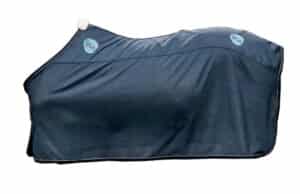
NOTE: Do not use magnets on open wounds; if you are pregnant; on mares in foal; or near pacemakers.
Pulsed Electromagnetic Field (PEMF) devices: These come under the heading of mechanical therapies and include infrared light products, lasers, and ultrasound devices.
PEMF blanket: Delivers pulsing electromagnetic fields which accelerate normal biological cellular reactions. Useful for a wide variety of concerns including pain and stress relief, reducing inflammation and increasing blood circulation. The blankets are suited for all tissue types including muscles, ligaments and tendons, and can help promote healthy joint function and optimise biomechanical efficiency. PEMF neck blankets, shoulder bands and front leg wraps are also available.
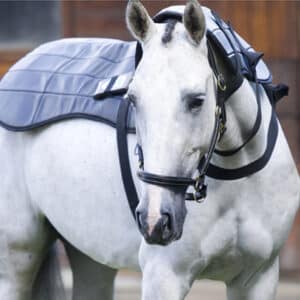
Red Light Therapy: Used for muscular, ligament and tendon injuries; bruising; oedemas; open wounds and wound healing; arthritis; fractures and splints. Red light therapy has been shown to increase healing times from injuries, and in some instances avoid the necessity for stressful and invasive recovery treatments. It’s an additional tool in a horse’s rehabilitation program after an injury or spell, helping to reduce swelling and repair damaged tissue after operations.

Photonic Torch: Throws a small beam of red light ideal for working on small areas.
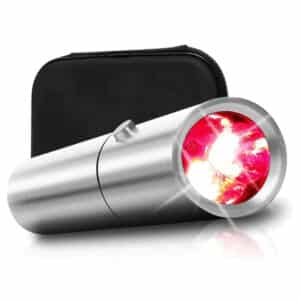
Laser Pen: Used for non-invasive targeted light therapy, it stimulates the body’s cells helping them to heal, recover and function effectively, and can promote general well-being.
Power Pad: A type of pad which combines the therapeutic effects of PEMF, light therapy and massage. It can be wrapped around a leg, placed on the horse’s back, the sacroiliac, or strapped to the neck or hindquarters.
Shockwave Therapy: This transmits a high-energy pressure wave to a precise location. Following a veterinary diagnosis, your vet will then direct the shockwave to the appropriate place and deliver the therapy. The shockwave stimulates healing and helps develop new blood vessels and bone at acute and chronic injury sites.
Therapeutic Ultrasound: These devices use sound waves to speed up healing by increasing blood flow, decreasing pain, and reducing swelling. The waves also gently massage damaged muscles, tendons or ligaments, which breaks down scar tissue and enhances cell repair. Veterinarians provide this therapy.
By now, the average horse owner might rightly be confused, as so many of these products are variations on a theme, which is why selecting the right therapy is best done under expert guidance. It is important to be confident you aren’t inadvertently treating a larger problem with a temporary or feel-good solution.
Manual Therapies
There are manual therapies which often can help, such as acupuncture, chiropractic, farrier work, massage, osteopathy, and physiotherapy.
Exercises may also be considered, including cavaletti and ground pole work, riding up and down hills, and reining back. Swimming, wading in pools, and walking on treadmills can also be beneficial. These exercises are generally used during later stages of healing or throughout longer-term programs to return horses to full fitness.
Carrot stretches could help. In two to three weeks they can increase flexibility, core strength and balance, and help with the rehabilitation of a musculoskeletal injury or neurologic disorder (as instructed by a vet). Using a carrot, the horse is lured through three different motions including rounding (flexion), hollowing (extension) and side to side (lateral) bending. During each exercise the horse moves under its own volition to gradually stretch its postural muscles and take each vertebra through a complete range of motion. Never force the horse into a position, as this could result in over stretching or injury.
PLEASE NOTE: While the remedies discussed above may prove useful, if your horse is injured or has other issues, you should contact your vet. They will determine the nature of the problem and recommend an appropriate treatment program.

